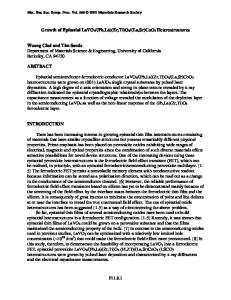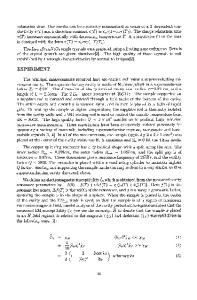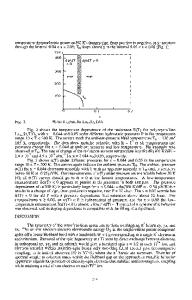Coupling of Lattice Dynamics to Spin Transitions in La 1-x Sr x CoO 3
- PDF / 135,726 Bytes
- 6 Pages / 612 x 792 pts (letter) Page_size
- 33 Downloads / 375 Views
Coupling of Lattice Dynamics to Spin Transitions in La1-xSrxCoO3 Despina Louca1 and J. L. Sarrao2 1 University of Virginia, Dept. of Physics, Charlottesville, VA 22903. 2 Los Alamos National Laboratory, MST-10, Los Alamos, NM 87545.
ABSTRACT La1-xSrxCoO3 is distinct because of its unique spin transitions subjecting the system to variable spin-lattice coupling. Pair density function analysis provided strong evidence for local lattice distortions associated with a Jahn-Teller active mode that is directly correlated to the change in the magnetic/conductive states of this system. The presence of Jahn-Teller distortions also serves as an indication for the intermediate spin configuration. Measurements of the dynamic structure function, S(Q, ω), showed that several phonon peaks fluctuate with carrier density and temperature. Such changes were not seen in an otherwise identical structure, LaAlO3. These phonon peaks are quite unusual and are most likely due to localized modes that appear to be dispersionless.
INTRODUCTION Perovskite systems often exhibit very distinct lattice distortions in response to their electronic degeneracies [1, 2]. Distortions are sometimes as manifestations of crystal field and JahnTeller (JT) effects. JT effects are strongly correlated to phenomena associated with metalinsulator transitions (MIT), magnetoresistance and even superconductivity in a variety of systems [3]. Their characterization has become crucial in defining the role of the lattice in the underlying mechanisms that sometimes produce exotic properties. JT modes couple the electronic degrees of freedom to the atomic motions resulting in strong electron-lattice interactions. The resulting atomic distortions can vary in length scales, from a few to hundreds of angstroms depending on the vibronic coupling strength. In addition, these modes can fluctuate in time, but sometimes their rate of fluctuation is quite uncertain. To determine the type of atomic distortions and how they fluctuate in time, two scattering techniques were combined: time-averaged and time-resolved neutron scattering. From this, one can obtain the average structure function, S(Qtotal) and the dynamic S(Q,ω). It is thus possible to estimate the limit on the energy scale of these fluctuations and at the same time determine the nature of the distortions. The cobalt system, La1-xSrxCoO3, with the typical perovskite crystal unit cell and rhombohedral symmetry has been chosen for this study. The Co perovskite is related to the colossal magnetoresistance (CMR) manganites [4] but it does not exhibit a large CMR effect. In the case of the manganites, it has been shown that the lattice plays an active role in the mechanism that brings about the CMR effect [5] whereas the role of the lattice in cobaltates is not well defined. The cobalt perovskite is fundamentally distinct from other perovskites because of its unique spin transitions [6, 7], subjecting the system to variable spin-lattice coupling depending on the spin D5.10.1 Downloaded from https://www.cambridge.org/core. Colu
Data Loading...










